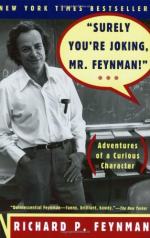|
This section contains 469 words (approx. 2 pages at 400 words per page) |

|
Surely You're Joking, Mr. Feynman! Summary & Study Guide Description
Surely You're Joking, Mr. Feynman! Summary & Study Guide includes comprehensive information and analysis to help you understand the book. This study guide contains the following sections:
This detailed literature summary also contains Topics for Discussion and a Free Quiz on Surely You're Joking, Mr. Feynman! by Richard Feynman.
"Surely You're Joking, Mr. Feynman!" is an autobiography of the late physicist, Richard P. Feynman—a very unconventional one. Rather than relating the story of his life in a traditional manner, Feynman gives us a collection of unconnected anecdotes loosely organized into this book. After reading the collection of anecdotes, which focus more on mundane details of his life than on major life events (such as marriages, births, for example) and great career accomplishments, what we end up with is a pretty good idea of the day-to-day life and personality quirks of this particular man, and insight into what makes him tick. At the end of the book, the unconventionality of format makes perfect sense, since we know its author is not the kind of person who will do anything the way everybody else does it. That said, it is possible (if a little confusing) to piece together the major events of Feynman's life, in roughly chronological order, from the information garnered in this book.
As a child on Long Island, Feynman is clearly highly intelligent and curious—qualities clearly encouraged and nurtured by his parents. He goes on to excel in his study of Physics at MIT and Princeton.
Upon completing his studies at Princeton, Feynman goes to work with the Manhattan Project in Los Alamos, New Mexico (to develop the nuclear bomb). Although young and obscure at the time, he is able to work among many of the most distinguished scientists of the time—most notably Niels Bohr.
After the war, Feynman takes a job as a professor at Cornell. He works and teaches there for several years before moving to CalTech. He decides CalTech is everything he ever wanted in a workplace and settles down there permanently. He establishes a reputation as a brilliant and accomplished physicist, and achieves worldwide recognition—including a Nobel prize in 1965. (However, the book tells us very little about the actual physics he does in his career).
Along the way to becoming a famous physicist. Feynman puts his inquisitive nature to work in many other areas, and learns a lot about the world outside of his department. He learns about biology, Mayan hieroglyphics, and the ins and outs of Japanese culture. He learns to speak Portuguese, play the drums, profit from gambling, and achieves some recognition as an artist.
Feynman is speaking to us from late in his life, when he has reached the very top of his profession. While he is clearly aware of his own intelligence, his tone is very accessible and encouraging. (it is no wonder he places such a high value on teaching—which is somewhat unusual for a professor of his clout). He encourages his readers to take pleasure in exploring natural and cultural phenomena for themselves.
Read more from the Study Guide
|
This section contains 469 words (approx. 2 pages at 400 words per page) |

|



